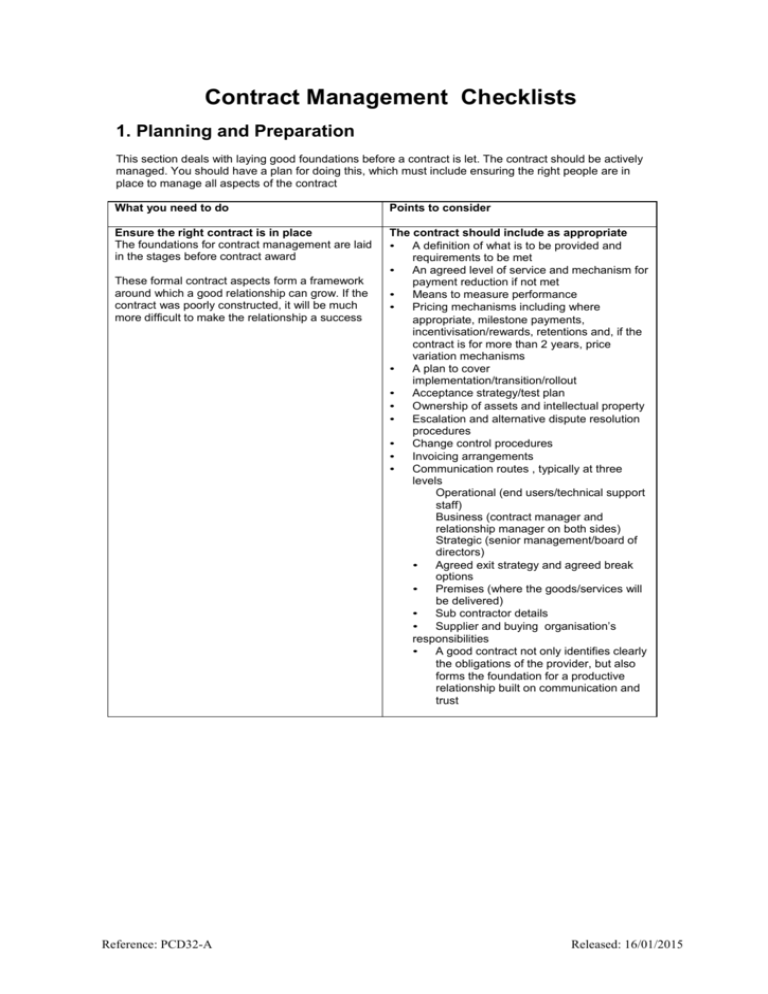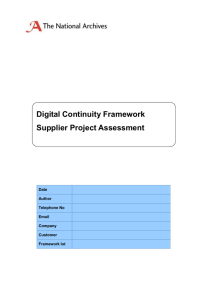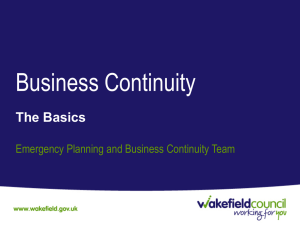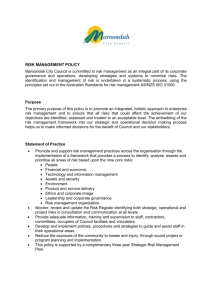Contract Management Checklist Document
advertisement

Contract Management Checklists 1. Planning and Preparation This section deals with laying good foundations before a contract is let. The contract should be actively managed. You should have a plan for doing this, which must include ensuring the right people are in place to manage all aspects of the contract What you need to do Points to consider Ensure the right contract is in place The foundations for contract management are laid in the stages before contract award The contract should include as appropriate • A definition of what is to be provided and requirements to be met • An agreed level of service and mechanism for payment reduction if not met • Means to measure performance • Pricing mechanisms including where appropriate, milestone payments, incentivisation/rewards, retentions and, if the contract is for more than 2 years, price variation mechanisms • A plan to cover implementation/transition/rollout • Acceptance strategy/test plan • Ownership of assets and intellectual property • Escalation and alternative dispute resolution procedures • Change control procedures • Invoicing arrangements • Communication routes , typically at three levels Operational (end users/technical support staff) Business (contract manager and relationship manager on both sides) Strategic (senior management/board of directors) • Agreed exit strategy and agreed break options • Premises (where the goods/services will be delivered) • Sub contractor details • Supplier and buying organisation’s responsibilities • A good contract not only identifies clearly the obligations of the provider, but also forms the foundation for a productive relationship built on communication and trust These formal contract aspects form a framework around which a good relationship can grow. If the contract was poorly constructed, it will be much more difficult to make the relationship a success Reference: PCD32-A Released: 16/01/2015 Be prepared to manage all aspects of the contract Upon contract implementation, C&SM activities can be divided into three areas: service delivery management relationship management contract administration • All three areas must be actively managed • Decide how to organise your people to manage each of the areas. You might assign a group or individual to each area or a single individual may cover two or more areas. Bear in mind that different areas will require different skills and knowledge • Put the right people in place to manage the Contract, and ensure adequate resource is provided Contract management forms the interface between demand (the customer organisation) and supply (the provider organisation) • Where possible, involve key contract management staff in contract development. The individual or team responsible for contract management must have adequate knowledge (business, contractual and technical) to understand both sides of the arrangement • Consider whether training is required for contract management staff • The skills and experience required to manage the relationship may be different from those required to manage service delivery • If you do not have expertise in house to manage a contract consider training existing staff or recruiting an experienced professional contract manager • Effective contract management is critical in ensuring that good supply chain/service delivery management is implemented over the duration of the contract • Embed sustainability performance criteria into the supplier programmes Feedback from suppliers (as well as the client’s perspective on the supplier’s performance) increases the likelihood of problems and issues being promptly identified and resolved. Managing the supply chain Once a supplier or suppliers are chosen and the contract awarded, the tender process is completed. At this point, there is considerable scope to work with suppliers to develop supply chain/service delivery capabilities Ensure there is mechanism for feedback on client performance Reference: PCD32-A • Released: 16/01/2015 2. Managing service delivery This section deals with establishing service levels and ensuring they are maintained. You may need to strike a balance between quality and cost to ensure a value for money outcome. This should include benchmarking to establish a “should cost” estimate. During this phase risks should be managed and business continuity plans should be in place should service failure or interruption occur. What you need to do Establish what levels of service are required, and ensure they are maintained Service level management is the process of managing the performance provided to the customer as specified in contractual performance metrics It balances cost and quality of services in order to provide the customer with value for money Points to consider • • There should be a detailed agreement of the required service levels and thus expected performance and quality of service to be delivered However, where specific service levels have been set, it may sometimes be appropriate to take a flexible approach to enforcement, particularly in the early stages of contract performance. Measure quality as well as quantity The quality of the service being delivered must be assessed This means creating and using quality metrics – measurements that allow the quality of a service to be measured • • Quality measures might include assessing aspects such as completeness, availability, capacity, reliability, flexibility and timeliness, among others Some aspects of a service may be measurable by numerical means; others may require subjective assessment Ensure value for money Ensuring value for money is about the balance between service quality and cost • • A key objective for contract management is to ensure that it continues to achieve value for money over its life • • Aim to optimise the ratio between value and cost Value for money is not synonymous with lowest cost Carefully consider all the benefits that the contract provides in relation to the ongoing investment it requires All costs associated with the contract must be taken into consideration, including: set up costs, recurring costs, fixed costs, unit costs and the organisation’s own overheads in managing the contract Compare prices and learn from others Benchmarking is the practice of making like for like comparisons between organisations with the aim of ensuring continuing value for money, getting better performance and improving business practices • • • • Reference: PCD32-A Price comparisons offer a quick and effective way to gauge whether you are getting value for money Providers could be obliged to benchmark their own costs or those of their subcontractors by the contract Compare the value for money you are getting with what other organisations are getting Compare the way you manage contracts with the way other organisations manage theirs Released: 16/01/2015 Managing Risks Risk is defined as uncertainty of outcome, whether positive opportunity or negative threat In contract management, managing risk means identifying and controlling factors that may have an impact on fulfillment of the contract • • • • • Risks can relate to many aspects of the contract, including fluctuation in demand, lack of provider capacity, change in requirement and transfer of skilled staff (on either side) All risks must be identified and managed Risks should be placed with the party best placed to manage them – possibly the provider, although they will want compensation for this. Risks placed with providers are referred to as transferred risks Business risk cannot be transferred to the provider. The final responsibility for achieving outcomes remains with the customer Ensure service continuity A major part of contract management is considering service continuity – what will happen if service fails or is interrupted • • • • Barring force majeure1, it will normally be the provider’s responsibility to manage service continuity, and this will be stipulated in the contract but it will need to be taken into account in the organisation’s wider business continuity plan. Where contracts are interrupted due to force majeure1, such as natural disasters or terrorist attacks, contract managers should work with the provider to identify the best way to enable the services to resume. Those aspects of a service identified as critical require careful consideration and the creation of a business continuity plan The risks associated with service interruption or failure should be identified, formally recorded in a risk register, assigned to an individual owner and actively managed in accordance with good risk management practice 1. Force majeure: unforeseeable circumstances that prevent someone from fulfilling a contract. Reference: PCD32-A Released: 16/01/2015 3. Managing the relationship This section deals with building up mutual trust and understanding to ensure there is openness in communication and a joint approach to managing delivery. When problems arise they should be dealt with promptly, which requires good communications channels with the aim of delivering “win/win” outcomes. What you need to do In addition to the more formal aspects of the contract(s), it is important that the relationship(s) is managed. It is in the organisation’s interest to make the relationship work Points to consider The three key factors for success are: • • • Mutual trust and understanding Openness and excellent communications A joint approach to managing delivery • The routes and media through which information will flow during the contract should be defined and ideally tested before the contract commences There are three levels of communication in a contractual arrangement: strategic (senior management/board of directors); business (contract managers on both sides); and operational (technical and frontline staff) Communication between supplier and client should be peer to peer; that is operational problems are resolved by staff at the operational level, not discussed with business managers Communication is crucial Good communications are always the make or break in managing a relationship They allow problems to be identified and resolved early, and build an atmosphere of mutual trust and appreciation of each other’s priorities • • Culture, attitude and behaviour are as important as the terms of the contract There will always be some tensions between the different perspectives of customer and provider. Contract management is about resolving or easing such tensions to build a win/win relationship • • • Consider whether the culture of the organisation will support the kind of arrangement that is sought The right attitudes will engender the right behaviours. Both sides’ objectives must be shared and understood, the arrangement directed to achieving them Adversarial approaches will increase the distance between customer and provider Deal with problems promptly However good the relationship between customer and provider and however stable the services being delivered, problems may arise • • • • Reference: PCD32-A The relationship managers should ensure that the provider has problem management procedures in place, including escalation procedures within the providers organisation and that these are used when needed These procedures should seek to prevent problems as well as resolve them The contract must define the procedures for undertaking corrective action if, for example, target performance levels are not being achieved If a dispute cannot be managed at the level at which it arises it will be necessary to escalate to a higher level of authority. This escalation process needs to be managed. Released: 16/01/2015 4. Contract Administration This section deals with the mechanics of the relationship between the customer and provider. In particular contract documentation must be maintained, especially where any changes to services, requirements, procedures or contracts are concerned. Senior management should be kept informed through a clear reporting mechanism. What you need to do Administration of the contract is important Contract administration is concerned with the mechanics of the relationship between the customer and provider Its importance should not be underestimated. Clear administrative procedures ensure that all parties to the contract understand who does what, when and how. Points to consider The elements that need managing are likely to include: • • • • • • • • • Contract maintenance and change control Notice periods, contract closure or termination Charges and cost monitoring Ordering procedures Payment procedures Budget procedures Resource management and planning Management reporting Asset management Maintain the contract documentation The contract will have to evolve to reflect changes in arrangements Contract maintenance means keeping the documentation up to date and relevant to what is happening on the ground • Establish procedures to keep contract documentation up to date and ensure that all documents relating to the contract are consistent and that all parties have the correct version Maintaining contract documentation is an important activity Reference: PCD32-A Released: 16/01/2015 Changes must be controlled • Changes to services, procedures or contracts may have an effect on service delivery, performance, costs and on whether the contract represents value for money. The specification and administration of change control is an important area of contract administration. • • • • Make sure management understands what is happening Management reporting procedures ensure that information about problems with a contract reaches those with power to act as soon as it is possible Appropriate structures need to be in place with representatives of both customer and provider management for reviewing ad authorising change requests Be careful that changes do not fall outside the scope of the original OJEU advertisement and conflict with procurement regulations – seek advice if you’re unsure It is particularly important that additional demands on the service provider should be carefully controlled Formal authorisation procedures will be required to ensure that only those new requirements that can be justified in business terms are added to the service contract A single change control procedure should apply to all changes Requirements for service performance reports and management information should be built into the contract and confirmed at the tender stage. Where possible, use should be made of the provider’s own management information and performance measurement systems For many business managers a summary of the service they have received along with a note of exceptions is normally sufficient Information requirements may change over the life of a contract 5. Seeking Improvements This section deals with seeking to make improvements principally through providing incentives to the provider; usually these are built into the contract itself. The aim is to have a continuous improvement in performance or value for money. What you need to do Give providers reasons to improve The aim of incentives is to motivate the provider to improve by offering increased profit, or some other desirable benefit, as a reward for improved performance or added value Reference: PCD32-A Points to consider • Types of provider incentive include guaranteed levels of capacity, revenue sharing and commercial opportunities • Incentives to improve are normally built into contract terms • It is important that incentives are balanced. They should not emphasise one aspect of performance at the expense of other, perhaps less visible, aspects • Financial incentives should offer rewards to both parties that fairly reflect any investment they have to make to achieve the saving in the first place • Seek to bring down costs, not margins, to allow a supplier a reasonable return to cover such items as training and development Released: 16/01/2015 Public sector managers are under constant pressure to improve. In contract management this translates into a need for continuous improvement in the performance or value for money of providers’ services Reference: PCD32-A • • A requirement for continuous improvement can be built into the contract, for example through a price decreasing year on year It is important that continuous improvement is seen as being desirable and beneficial to both parties rather than as a means to drive down prices Released: 16/01/2015






